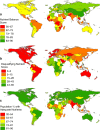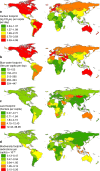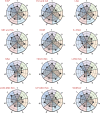Multi-indicator sustainability assessment of global food systems
- PMID: 29487286
- PMCID: PMC5829192
- DOI: 10.1038/s41467-018-03308-7
Multi-indicator sustainability assessment of global food systems
Abstract
Food systems are at the heart of at least 12 of the 17 Sustainable Development Goals (SDGs). The wide scope of the SDGs call for holistic approaches that integrate previously "siloed" food sustainability assessments. Here we present a first global-scale analysis quantifying the status of national food system performance of 156 countries, employing 25 sustainability indicators across 7 domains as follows: nutrition, environment, food affordability and availability, sociocultural well-being, resilience, food safety, and waste. The results show that different countries have widely varying patterns of performance with unique priorities for improvement. High-income nations score well on most indicators, but poorly on environmental, food waste, and health-sensitive nutrient-intake indicators. Transitioning from animal foods toward plant-based foods would improve indicator scores for most countries. Our nation-specific quantitative results can help policy-makers to set improvement targets on specific areas and adopt new practices, while keeping track of the other aspects of sustainability.
Conflict of interest statement
The authors declare no competing interests.
Figures




References
-
- United Nations. Transforming our World: The 2030 Agenda for Sustainable Development. Report No. A/RES/70/1 (United Nations, New York, USA, 2015).
-
- Kanter DR, et al. Translating the sustainable development goals into action: a participatory backcasting approach for developing national agricultural transformation pathways. Glob. Food Sec. 2016;10:71–79. doi: 10.1016/j.gfs.2016.08.002. - DOI
Publication types
MeSH terms
LinkOut - more resources
Full Text Sources
Other Literature Sources
Miscellaneous

